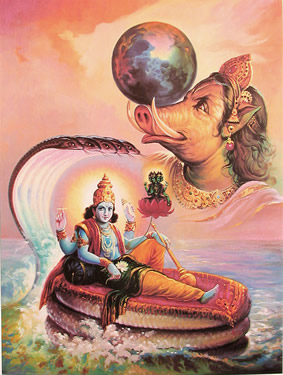 |
Essence Of
Varaha Purana
|
| 44 Regulations concerning Last Rites-Pitru Yagna | |
Varaha Deva told Bhu Devi about the significance of Pitra Yagna stating that it was Sage Nimi who started the practice of the Last Rites when the Sage lost his son, Sage Atreya. Nimi could not overcome the grief for three consecutive days and nights.Thereafter, he decided to surmount the sorrow by performing the last rites on the twelfth day ie the day of the ‘Asuchi’ or impurity after the death. He performed the rituals of Shraddha on one day which would have taken a week normally.He also executed ‘Pinda Daan’by donating cereals, vegetables and fruits and with his hands along with kusa grass pointing to South recited the departed soul of his son’s name and Gotra. On that day, he invited Brahmanas and gave them a feast along with those food delicacies which his son would have liked to enjoy. But the sense of grief and guilt tormented Nimi who even contemplated a bid on suicide. Meanwhile Maharshi Narada arrived and assuaged the intense feelings of Nimi and confirmed that whatever was being performed was quite in consonance with the regulations approved by Brahma. As the person whose custody was being taken by Yamaraja and followers should be transferred to a kusha mat while chanting the Mantra ‘OM’and Divya Gayatri and quikly wrap up over the body a ‘Madhuparka’with the Mantra: Om Gruhana chemam Madhuparkamaadyam Samsaranashanakaram Tvamrutena Thulyam Narayanena Rachitam Bhagavatpriyanam Daahecha Shantikaranam Suraloka pujuyam (Om, take this Aaadya madhuparakam; this discards Samsaarik connections and connects with Amrit or eternal ties inspired and loved by Narayana Himself; your thirst would be quenched and grants Peace and is adorable in Devaloka!). After applying scented materials and oils, the permanent shine of the body and face be brought once and for all, place the head down towards Ganga and other Tirthas available and perform bathing, arrange head towards north and feet towards South on the ‘chita’ and whoever is the Kartha(s) should invoke Agni reciting the Mantra:’Krutva Dushkaram Karma jaanatha vaapyajaanatha, Mrityu kaala vasham praapya Narah Panchatva maagahatah / Dharmaadharma samayuktho Lobha moha samaavrataha, Daheyam Sarva gaathraani Divya lokaani gatcchatu’ / ( Either knowingly or unknowingly, this person’s soul may have committed sins and right now is in the grip of Mrithyu (death) and has been absorbed in ‘Pancha Tatvas’; this body with Lobha ( greed) or moha ( attachment) as also Virtue or Vice is being consigned into flames and its Soul be transferred to Divya Lokas!). Having said this and made ‘Pradakshina’, the Kartha(s) should look at head down to Agni Deva and after taking bath return home.Since then as ‘Ashuchi’ commences and Deva karyas should not be carried out. This Procedure of ‘Antima Samskar’ (Last Rites) is applicable to all the Four Varnas. On the Third Day of the death, the Kartha(s) should take bath in a River or running waterbody and along with three‘Pindas’ give away three ‘Jalaanjalis’. On the fourth, fifth and sixth days, only one Pinda and three ‘Jalanjalis’ be repeated. On the Seventh and Eighth days the same be executed but at another place. On the Ninth day, those Brahmanas who were commissioned for the Pitru Karya should recite Puranas without taking cooked food; they would eat only on the thirteenth day. On the Tenth day, the Kartha (s) should have the head tonsured and wear new clothes. On the eleventh day, all the Sagotris take bath with oil and on the twelfth day would be performed ‘Ekodishta Shraddah’. Pinda-Pradan is to be done as per procedure; the Pindas need to be considered as the departed souls themselves with unmitigated reverence and selflessness.On the Thirteenth day, a feast is arranged to Brahmanas, relatives and friends; ‘Daanas’are also performed to liberate the deceased Soul and donations are made too in the form of cereals, umbrellas, and dakshina.Besides other Danas, Go-daan indeed acquires significance.The procedure is to be carried out every month till the arrival of the same day a year hence and till that time, the departed soul is not freed from the ‘Pretavastha’. Thereafter, the Annual ceremony becomes a regular feature as long the Kartha lives. | |
 Prev:Vishnu Puja-‘Aparadha Prayaschyas’ (Correctives for misdeeds) Prev:Vishnu Puja-‘Aparadha Prayaschyas’ (Correctives for misdeeds) | |
 Next:Vishnu Puja-‘Aparadha Prayaschyas’ (Correctives for misdeeds)
Next:Vishnu Puja-‘Aparadha Prayaschyas’ (Correctives for misdeeds)